January 8, 2024
What Is The Best Community Engagement Method In 2024?

Dominic
You’ve started a community and people are trickling through the door. “They” say your first 100 users are your most important so you go looking for the best community engagement method.
But where do you start?
It could be Google, it could be your mentor, or it might even be the people in your community.
There are plenty of great online communities out there. Some more successful than others.
Sure, some have shortcut their way to success. It helps if you already have a large following.
For example, Rodolphe Dutel, Founder of Remotive, points out that “It’s crazy hard to pull off a paid-for community unless you have either a cult-like following, newsletter with 10,000+ subscribers, loads of VC money, or unfair organic traffic.”
In which case, starting an online community is a no-brainer. And community engagement is hard to get wrong. Though, one day, if you don’t keep tabs on engagement, you might find you’ve got a lot of members but little engagement.
In this article, we’ll start with some of the traditional community engagement methods then move on to some more creative ideas. We also hear first-hand from community founders who’ve seen success through various tools and techniques.
What is best practice in community engagement?
The clue is in the question. Engaging with your online community (or, in fact, your real-life community) means getting to know them.
If you run a community of any type, it can’t be a one-way relationship. At least, not until you’ve developed evangelists and community champions. Then you might have the comfort of others spurring people into action.
These are people who live and breathe the community you’ve created. It’s a bit like starting a business and hiring someone to run the day-to-day activities.
But you can only discover (and enable) these people by following these community engagement best practices.
1 - Participate
Participation is the name of the game. If nobody feels compelled to participate in your online community, it’s going to fail.
This means coming up with creative ways to draw people into action. You must participate and get things off the ground.
Start with the following:
Ask a daily question people actually want to answer
Make introductions
Find out how you can help on a 1:1 basis and apply this community-wide
Use integrations and automations to trigger activities
Share member successes
Introduce guest contributors
Share relevant content
Round up community activity once a week
Here’s an example of Jimmy Daly, founder of Superpath, an online community for content marketers. Every week, he cherry-picks the best conversations, jobs, and content, and shares community-wide.
If you’re running a Slack community, you can send an @everyone message in your #announcement channel.
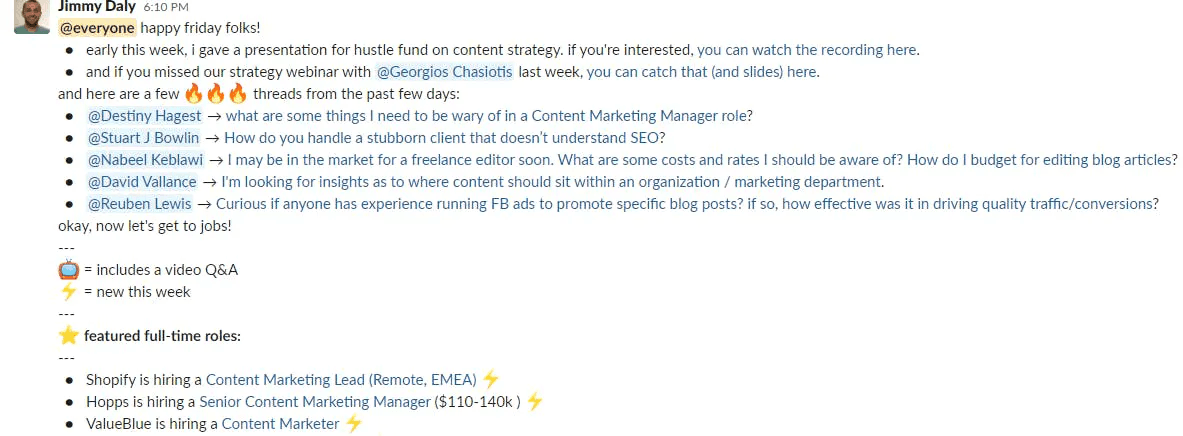
These are all things you can do to trigger community participation. When you’re seen to be an active member of the community, it will drive others to follow your behavior.
2 - Simplify
Like most things in life, if you make it easy for people to take part in your community, there’s a higher chance they will.
Start at the very top.
Which platform(s) are you going to use?
When you’re deciding where to host your community, don’t choose the platform you feel the most comfortable on. Choose the platform most familiar to your members.
It might be most profitable for you to start a Patreon. But, if all your members already have Slack then it’s a no-brainer. There’s a wealth of community platforms available.

Choosing the right one is crucial.
If you’re likely to be using several platforms, make sure they integrate. Otherwise you run the risk of information gaps and confusion over when to use which app when.
For example, you can now use Discord and Patreon together. If you run a Patreon and offer a private Discord server, integration allows for flow of data between both apps.
How do you give members a voice?
Once you’ve decided on a platform, you need to enable members to be heard. You might leave this to chance and hope people start interacting. But a more active way is to create a safe space with clear guidelines.
If you do opt for a Slack workspace, establish clear etiquette per channel and communicate how people should use them.
It might be the case that everyone already uses Slack so a reminder to use threads for long conversations is reassuring. But for irregular Slack users, they need a steer on when it’s okay to use emojis and GIFs.
Only when your members feel comfortable and confident, will they interact with each other.
How do you make content most accessible?
It may take some time to discover what’s most popular in your online community. During this phase, you should experiment with different formats and content types.
Consider the following:
Rounding up conversations in a message
Creating blog posts out of those messages
Recording an asynchronous video
Creating an infographic
Use these formats as a way to engage community members but also to find out how members react to different types.
For example, Araminta Robertson, who runs Fintech Marketing Hub, says to create articles or content that answers the most frequent questions people have in the community.
Rather than answering questions into walls of text on Slack, why not create articles other members can read and bookmark?
Members can then share them outside of your community and they become assets to drive new member sign-ups.
When you’ve experimented with all these formats, create a poll and see what resonates best with your community. This doesn’t mean removing one format completely but you can start to tailor what you share and how.
3 - Reward
When people do something great (or maybe just good) in your community, make sure people know about it.
This might be a thank you message for referring a new member to your community. It could be mentioning an award someone received.
But you could go even further. When people start contributing engaging content and helpful answers, recognise outstanding efforts.
You could start small by offering a gift card or a service. If you have a product, consider giving them free access.
Online community platforms like Sociabble even have community leaderboards. Members can score points for carrying out different activities.

In this example, there’s no monetary reward. But a sense of giving and achieving.
Whatever you decide on, make sure it doesn’t become a one-horse race. When the same person wins every time, community engagement dwindles.
4 - Build trust
Nothing is more trusting than a face. But don’t go plastering your headshot over everything.
(Though a custom emoji with your face on in Slack is quite hilarious.)
Instead (or as well as if you really like the headshot idea), create videos to broadcast to your community.
When a new member joins your community, prepare a welcome video that automatically gets sent to them. You could set up an email sequence or a custom response in Slack, perhaps.
Use Tella to record your onboarding/welcome message in minutes. Check on this welcome video from Connor Finlayson.
Research shows that 97% of people think that video is an effective tool to welcome and educate people.
So a blanket welcome message to members could go a long way.
Benefits of recording such a video include:
Putting a face to the name.
Elaborating on welcome messages.
Hearing your passion for the community.
Asking your new member to take their first action (we’re here to drive engagement in your community after all).
For product communities, you could create a knowledge base of walkthrough videos like Draftbit. For anyone looking for help with your product, you can direct people to your video bank rather than becoming overrun by support tickets.
Read: How Draftbit Scaled User Onboarding with a Video Knowledge Base
Like with employee onboarding videos, you can create community onboarding videos to walk people through how to use whatever tool you’ve chosen, best practices you’ve developed, and anything useful they might need to know.
What are some more creative types of community engagement?
So that was the bare bones of community engagement methods. For any online community to succeed, they need to be doing those as a minimum.
What will really make your online community stand out is going the extra mile.
Give some of these a try and see if they become your favourite community engagement methods…
1 - Create bespoke videos to give your community a face (and voice)
Making a catch-all welcome video is easy. Almost too easy.
Like any form of marketing, those who invest in personalisation are more likely to keep paying members.
Now, it sounds like creating a new video for every member would be a lot of work.
We’re not going to lie to you. It is.
Instead, use Tella to record the bulk of your message, store it in your video library, then record personalised introductions.
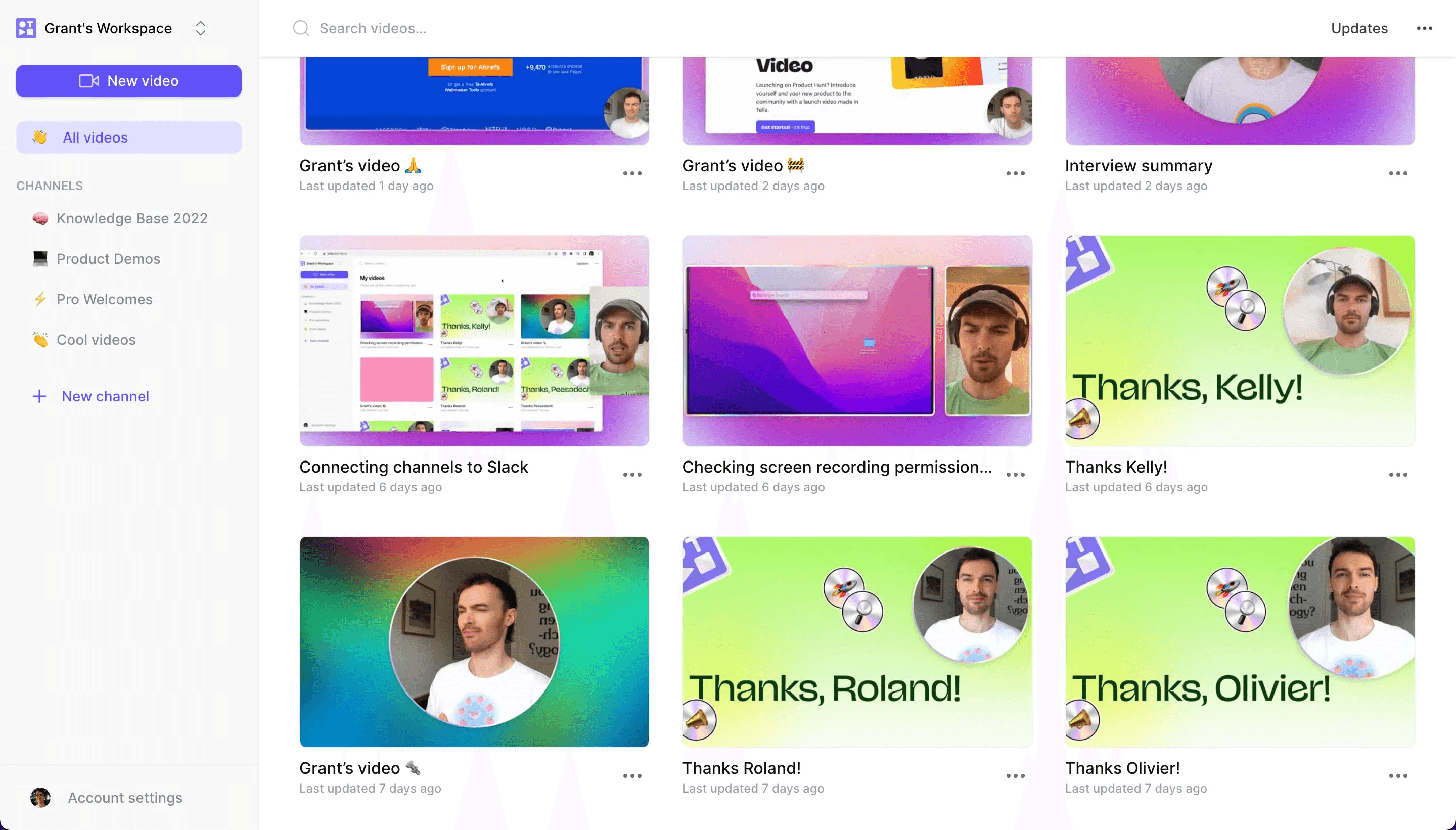
For example, let’s say Lizzie joins as a new member. You’ve already recorded a 60-second clip walking members through the basics of your community. And you’ve got a 5-minute demo of how to use the technical features.
In this scenario, you just need to record a 30-second “Hello Lizzie, so nice to see you here. I love what you’re doing at ABC Corp and hope this online community helps you out.”
Combine this clip with your other two and you’ve got a custom video for every new member.
Nice hack or what?
And they keep on coming. This one from Marcia Chadly, a Mighty Networks Consultant at Chadly Creative Consulting:
“I try not to do anything without captions. I want things to be as accessible as possible, and for the rest of people it just helps them out. 50+% of people on my YouTube channel watch my videos with captions on.”
2 - Encourage video usage among your community members
If the welcome videos are a hit, why not encourage more video usage throughout?
It seems the norm to invite members to a weekly/monthly Zoom call but what about those who are busy during that time? Or your members that don’t like gathering with a group of strangers?
You could get everyone to sign up to Tella and record videos in the same format as your welcome video.
Sounds expensive? You only need to pay for Tella if you need the premium features or when you go over your 10 video limit. And by that point, there’s obvious value and you’ll start using videos to boost engagement everywhere.
For your members, you could either wrap in the cost of a premium Tella license or get them to sign-up for a free version.
You can even send them this video to help them get started:
3 - Start a job board
It might not be your goal to start a revenue stream through posting job ads but it sure is a great way to keep people engaged.
Even passive onlookers are interested in seeing what’s on the market, what competitors are paying, and even just what responsibilities are included in roles like theirs. They might not want to spend time exploring job search websites like Jooble and Glassdoor, but likely won't mind community job updates.
Then there are those who are looking for a new role and your community could be the place where hirers and candidates come together. When you group jobs and people together in the same community, you get far superior results to a public job board.
The Superpath job board has seen extreme success for both members and its business model.
Members can either search the website for new (relevant) jobs…

Or get a notification in the #job-listings Slack channel.

As well as engaging community members who want to post and apply for jobs, there’s the added benefit of generating a new revenue stream. You gotta pay the bills, after all!
4 - Host AMAs with influencers and peer-level guests
In any online community, variety is the spice of life. While people may join because they are invested in the same things as you, they don’t want a dictatorship.
Every now and again (or on a regular basis), invite outsiders to star as guest speakers or contributors in your community.
It might be a podcast where you have industry leaders asking questions members pose. It could be a written ask-me-anything (AMA) on social media or internally within your community tool.
Fintech Marketing Hub regularly invites guest speakers onto its podcasts.

The key is to keep it fresh. And inviting external folks to take part can only be a good thing for growing your community.
To be successful with some of these more creative types of community engagement, consider using these community tools…
Recommended community tools
1 - Tella
Tella is an asynchronous video platform that allows you to record videos online for free.
You can record videos of just you talking, share your screen, and even side by side clips.
While you can record clips in Slack now, they are limited to five minutes and have minimal functionality.
With Tella, you get access to features like cropping, backgrounds, merging clips, and plenty more fun stuff if your heart desires.
Jeremy Enns, who runs Podcast Marketing Academy, likes how Tella videos catch people’s eye.
“It sends a signal to your community, that you care about what you’re sharing with them”
Learn about one Tella's newest editing features below.
Just shipped our huge update to trimming 🚤 here's what it can do:
🤺 Split clips and remove parts
👻 Find the right spot with our ghost cursor
⌨️ Handy keyboard shortcuts
↩️ Works with undo and redo
💥 Still non-destructive
⚡️ Still instant :)
Try it at https://t.co/GpxzFbGpZ1 pic.twitter.com/mF3MsIKQDy— Tella (@TellaHQ) April 20, 2022
When you’re done recording, you can share a link to your video with one click!
You may also like: What Is Asynchronous Video Anyway?
2 - Scales
Scales connects people for digital meetups, automatically inviting them to a shared calendar event with a link to a secure video chat.
When you join a community program, Scales matches your interests with another member of the group.
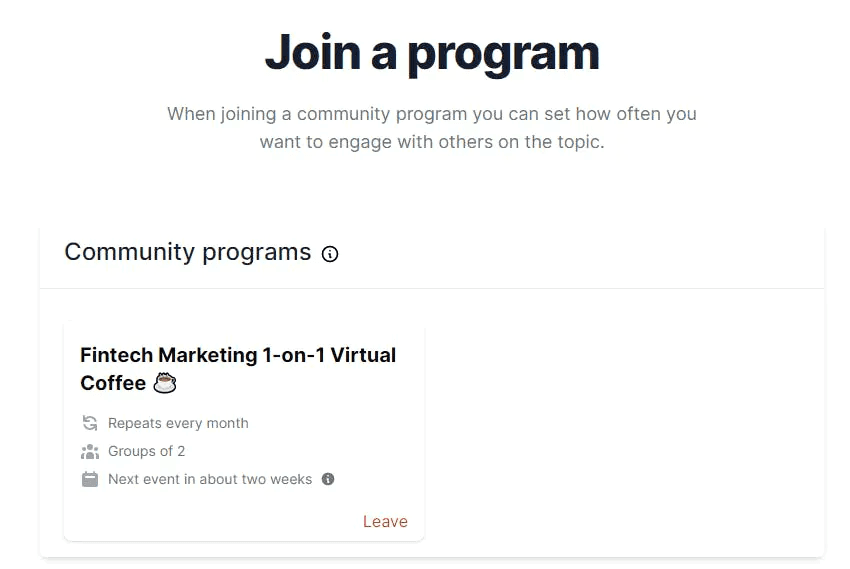
You can choose from monthly or fortnightly meetups with someone who shares a common interest. It’s a bit like Donut but with some logic applied rather than meeting a random person in your Slack group.
Araminta Robertson (from earlier in the article and Fintech Marketing Hub) says she implemented Scales and one of her members got a job through it.
3 - Typeform
Typeform is an online survey tool that allows you to capture feedback and conduct independent research.
Feedback is crucial to the running of any online community. Gathering data and first-hand knowledge from members provides you with a real-life look at if you’re succeeding.
Try creating a Typeform to get clear responses of what’s going down well. It only takes a few minutes to create a basic form. Though, you could spend really quite a long time making it look beautiful and applying custom logic.
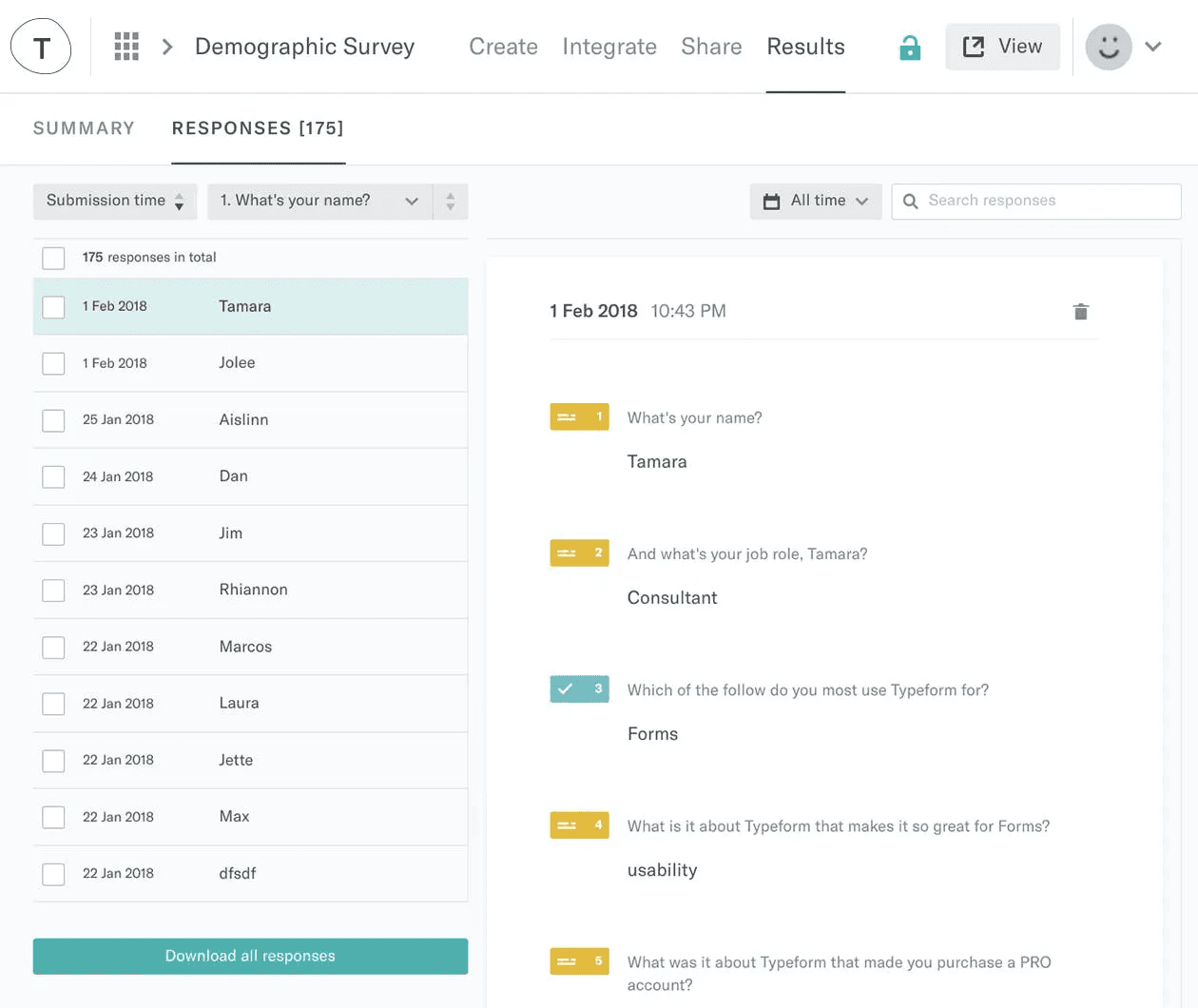
If your community is based within Slack, you could use the Polly as a free alternative. Check whichever platform you’re running to see if you have this functionality built-in. If not, Typeform is a superb paid version.
4 - Circle
If you haven’t already selected a platform to host your community, look no further than Circle.
Circle is an all-in-one community platform for creators and brands alike.
You get access to live streaming, weekly digests, and lure in new members with free access.
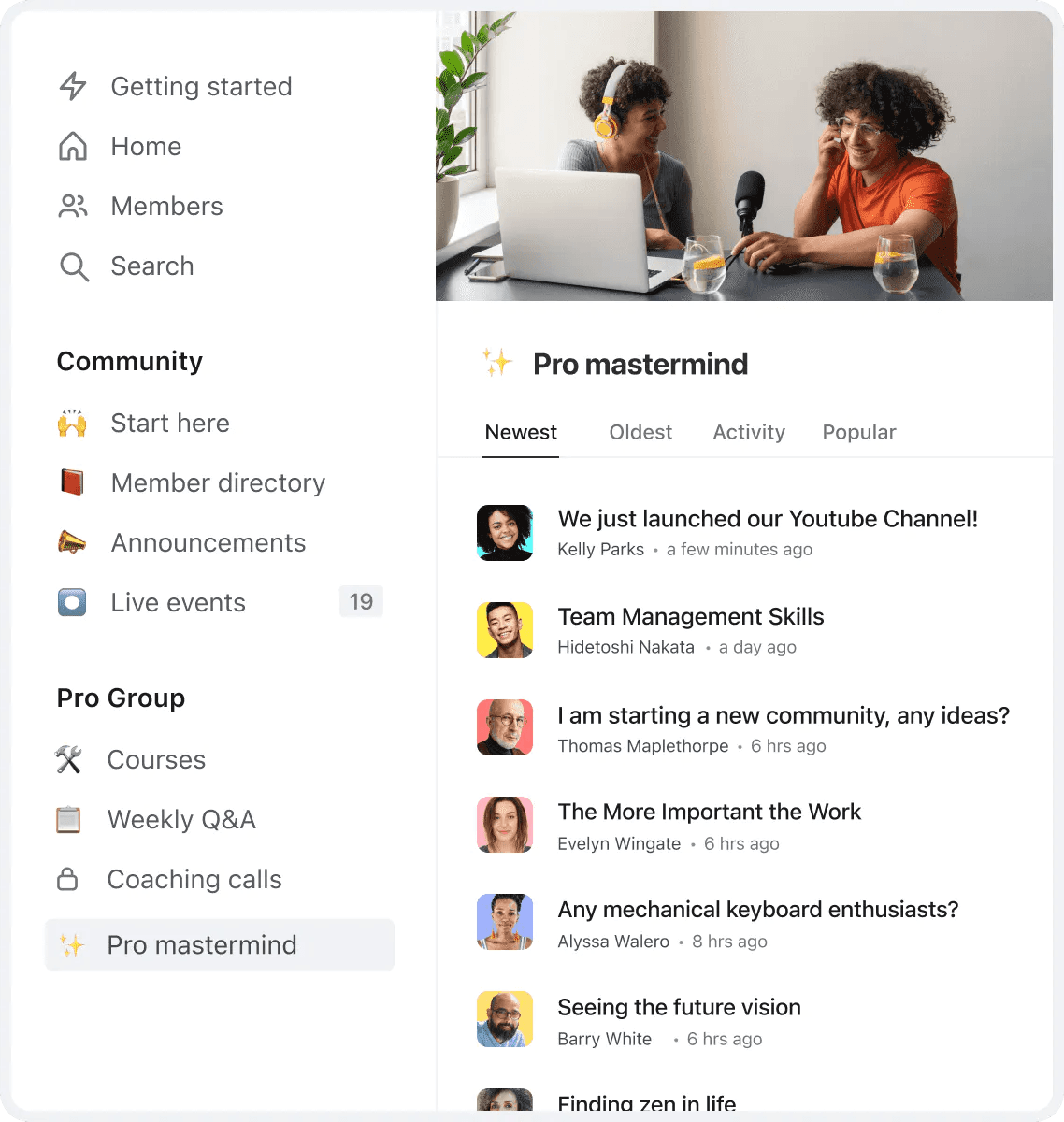
With over 4,000 communities and 2 million members, you can create (and monetise) a community on a slick user interface with built-in tools like group chat rooms, event spaces, and private messaging.
You can even get a free 14-day trial to test it out before you invite your first member.
So, what is the best community engagement method in 2022?
We say video. And 97% of people agree it’s an effective community engagement method.
But that doesn’t mean you have to have one-to-one Zoom calls with every member. Far from it.
Using Tella to create async videos for one-to-chat chats or at a broadcast level saves the time and effort of mass video production while engaging users to spend more time with you and your community.
Think of the time it takes to log in, check for messages, and browse what’s happening.
A minute. Two if you’re lucky.
With a video, personalised to the viewer, you’ve captured their attention and given them a reason to stick around. Their time with you increases exponentially.
Sounds pretty good, right?



